
FACULTY OF ARTS AND SCIENCES
Department of English Translation and Interpreting
İMT 310 | Course Introduction and Application Information
| Course Name |
Turkish Sign Language*
|
|
Code
|
Semester
|
Theory
(hour/week) |
Application/Lab
(hour/week) |
Local Credits
|
ECTS
|
|
İMT 310
|
Fall/Spring
|
3
|
0
|
3
|
4
|
| Prerequisites |
None
|
|||||
| Course Language |
Turkish
|
|||||
| Course Type |
Elective
|
|||||
| Course Level |
First Cycle
|
|||||
| Mode of Delivery | Blended | |||||
| Teaching Methods and Techniques of the Course | Practical demonstrationPerformanceLecture / Presentation | |||||
| Course Coordinator | ||||||
| Course Lecturer(s) | - | |||||
| Assistant(s) | - | |||||
| Course Objectives | The aim of this lesson is to teach the sign language used by deaf community and to make students skillful at using sign language in social life. |
| Learning Outcomes |
The students who succeeded in this course;
|
| Course Description | In this course, the history, alphabet, and basic concepts of Turkish Sign Language will be taught. Within the framework of this course, hearing individuals will be educated on sign language as a visual language, enabling them to have basic knowledge of the sign language to help deaf individuals in a variety of community settings such as hospitals, schools, courtrooms or police stations. |
|
|
Core Courses | |
| Major Area Courses | ||
| Supportive Courses | ||
| Media and Management Skills Courses | ||
| Transferable Skill Courses |
X
|
WEEKLY SUBJECTS AND RELATED PREPARATION STUDIES
| Week | Subjects | Related Preparation |
| 1 | General characteristics of Turkish Sign Language: Definition of the letters, movements of hands and fingers Showing the letters in Turkish alphabet in Turkish Sign Language | Atila, M. (2011).Konuşan eller:Temel işaret dili. İstanbul: İlgi Kültür Sanat Yayınları, 1-6. ISBN: 9944979619. |
| 2 | Fingerspelling, family and relatives, signs related to our body Health terms; showing health terms in Turkish Sign Language | Atila, M. (2011). Konuşan eller:Temel işaret dili.İstanbul: İlgi Kültür Sanat Yayınları, 7-20. ISBN: 9944979619. |
| 3 | Showing health terms in Turkish Sign Language (Cont’d) Translating sentences with health terms Time and time periods in Turkish Sign Language | Atila, M. (2011). Konuşan eller:Temel işaret dili. İstanbul: İlgi Kültür Sanat Yayınları, 96-102. ISBN: 9944979619. |
| 4 | Verbs Showing colors in Turkish Sign Language Antonyms Emotions in Turkish Sign Language | Atila, M. (2011). Konuşan eller:Temel işaret dili. İstanbul: İlgi Kültür Sanat Yayınları, 103-162. ISBN: 9944979619. |
| 5 | Adjectives; Mathematics and Unit of Measures in Turkish Sign Language | Atila, M. (2011). Konuşan eller:Temel işaret dili. İstanbul: İlgi Kültür Sanat Yayınları, 72-114. ISBN: 9944979619. |
| 6 | House and furniture Exemplification and forming a sentence in Turkish Sign Language | Atila, M. (2011). Konuşan eller:Temel işaret dili. İstanbul: İlgi Kültür Sanat Yayınları, 21-36. ISBN: 9944979619. |
| 7 | Food and Beverage; Kitchenware in Turkish Sign Language | Atila, M. (2011). Konuşan eller:Temel işaret dili. İstanbul: İlgi Kültür Sanat Yayınları, 37-50. ISBN: 9944979619. |
| 8 | Midterm | |
| 9 | Legumes and dried fruits: Food translation | Atila, M. (2011). Konuşan eller:Temel işaret dili. İstanbul: İlgi Kültür Sanat Yayınları, 47-60. ISBN: 9944979619. |
| 10 | Hand tools and Machines; Clothing – Accessories Mines in Turkish Sign Language | Atila, M. (2011). Konuşan Eller:Temel işaret dili. İstanbul: İlgi Kültür Sanat Yayınları, 61-65. ISBN: 9944979619. |
| 11 | School and Education; Music terms in Turkish Sign Language | Atila, M. (2011). Konuşan eller:Temel işaret dili. İstanbul: İlgi Kültür Sanat Yayınları, 7-17. ISBN: 9944979619. |
| 12 | Jobs; Animals; Directions | Atila, M. (2011). Konuşan eller:Temel işaret dili. İstanbul: İlgi Kültür Sanat Yayınları, 66-72. ISBN: 9944979619. |
| 13 | Sport terms, Weather and Geography Terms; Cities in Turkey; Countries | Atila, M. (2011). Konuşan eller:Temel işaret dili. İstanbul: İlgi Kültür Sanat Yayınları, 73-118. ISBN: 9944979619. |
| 14 | Grammar in Turkish Sign Language; Communication and Comprehension in Turkish Sign Language | overview, video analysis, sentence translations |
| 15 | Review of Semester | |
| 16 | Final Exam |
| Course Notes/Textbooks | Atila, M. (2011). Konuşan eller:Temel işaret dili. İstanbul: İlgi Kültür Sanat Yayınları. ISBN: 9944979619. |
| Suggested Readings/Materials |
EVALUATION SYSTEM
| Semester Activities | Number | Weigthing |
| Participation | ||
| Laboratory / Application | ||
| Field Work | ||
| Quizzes / Studio Critiques | ||
| Portfolio | ||
| Homework / Assignments |
1
|
10
|
| Presentation / Jury | ||
| Project | ||
| Seminar / Workshop | ||
| Oral Exams | ||
| Midterm |
1
|
30
|
| Final Exam |
1
|
60
|
| Total |
| Weighting of Semester Activities on the Final Grade |
2
|
40
|
| Weighting of End-of-Semester Activities on the Final Grade |
1
|
60
|
| Total |
ECTS / WORKLOAD TABLE
| Semester Activities | Number | Duration (Hours) | Workload |
|---|---|---|---|
| Theoretical Course Hours (Including exam week: 16 x total hours) |
16
|
3
|
48
|
| Laboratory / Application Hours (Including exam week: '.16.' x total hours) |
16
|
0
|
|
| Study Hours Out of Class |
14
|
2
|
28
|
| Field Work |
0
|
||
| Quizzes / Studio Critiques |
0
|
||
| Portfolio |
0
|
||
| Homework / Assignments |
1
|
12
|
12
|
| Presentation / Jury |
0
|
||
| Project |
0
|
||
| Seminar / Workshop |
0
|
||
| Oral Exam |
0
|
||
| Midterms |
1
|
15
|
15
|
| Final Exam |
1
|
17
|
17
|
| Total |
120
|
COURSE LEARNING OUTCOMES AND PROGRAM QUALIFICATIONS RELATIONSHIP
|
#
|
Program Competencies/Outcomes |
* Contribution Level
|
||||
|
1
|
2
|
3
|
4
|
5
|
||
| 1 | To be able to use advanced, field-specific conceptual, theoretical, and practical knowledge acquired, |
|||||
| 2 | To be able to analyze and research field-specific concepts and ideas and to interpret data individually or as a team using scientific methods, |
|||||
| 3 | To be able to understand and use grammatical and semantic structures of the source and target languages, |
X | ||||
| 4 | To be able to obtain information about social, cultural, and historical approaches within the source and target languages and to use this information for textual analysis and production, |
|||||
| 5 | To be able to understand and interpret written and oral texts in the source language and to transfer these texts into the target language using a semantically and functionally appropriate language, |
X | ||||
| 6 | To be able to produce creative translations and assess the translation products critically by defining the steps, strategies and problems in the translation process in the light of field-specific theoretical knowledge and skills acquired, |
|||||
| 7 | To be able to transfer the theoretical knowledge and research skills within different areas of expertise to translational act, |
|||||
| 8 | To be able to use computer-assisted translation tools and machine translation effectively at each step of the translation process, and to follow the theoretical and practical developments in these fields, |
|||||
| 9 | To be able to gain awareness of the translator’s social role, job profile, and professional ethical values and to acquire workload management skills for individual or team work, |
X | ||||
| 10 | To be able to access necessary sources to improve quality at each step of the translation process and to assess the target text in accordance with the quality objectives by using these sources, |
|||||
| 11 | To be able to establish effective oral and written communication skills both in English and Turkish, to be able to speak a second foreign language at a good level, to be able to use a third foreign language at intermediate level, |
|||||
| 12 | To be able to relate the knowledge accumulated throughout the human history to their field of expertise. |
|||||
*1 Lowest, 2 Low, 3 Average, 4 High, 5 Highest
NEWS |ALL NEWS
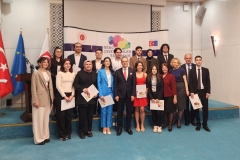
Young Translators from İzmir University of Economics Received Their Awards.
On April 16, 2024, in Ankara, the Directorate for EU Affairs hosted the Certificate Ceremony for the "Young Translators Competition," where 125
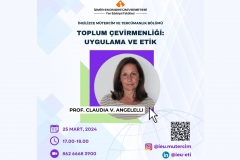
IUE Department of English Translation and Interpreting hosted Prof. Dr. Claudia V. Angelelli in the webinar titled "Community Interpreting: Practice and Ethics".
On Monday, March 25th, İzmir University of Economics Department of English Translation and Interpretation organized a webinar titled "Community Interpreting: Practice and
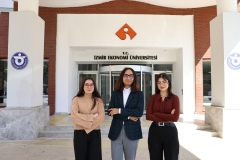
Returned to Izmir with three awards
The Young Translators Competition organized by the Ministry of Foreign Affairs Directorate for EU Affairs was marked by the success of Izmir
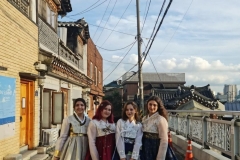
International agreements with 203 universities
Izmir University of Economics (IUE), who has signed international agreements with 203 universities with the aim of enhancing the educational opportunities offered
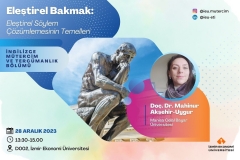
“Basics of Critical Discourse Analysis" Seminar at IUE English Translation and Interpreting Department
Izmir University of Economics, Department of English Translation and Interpreting, organized a seminar titled " Turning a Critical Eye: Basics of Critical
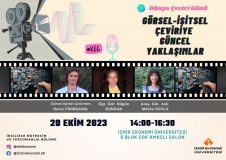
Within the framework of International Translation Day, IUE Department of English Translation and Interpreting, Faculty of Arts and Sciences, organized a panel titled "Current Approaches in Audiovisual Translation".
Within the framework of International Translation Day (September 30th), the Department of English Translation and Interpreting at Izmir University of Economics hosted
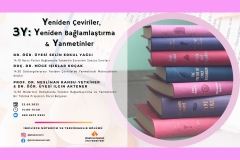
“Re-translations, Re-contextualization, and Paratexts” Panel at IUE English Translation and Interpreting Department
Izmir University of Economics, Faculty of Arts and Sciences, Department of English Translation and Interpreting organized an online panel titled "Re-translations, Re-contextualization,
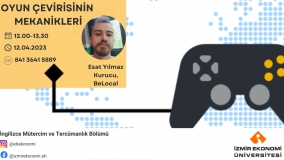
As part of the webinar series, IUE Department of English Translation and Interpreting, Faculty of Arts and Sciences, hosted Esat Yılmaz
IUE Department of English Translation and Interpreting, Faculty of Arts and Sciences, hosted Esat Yılmaz, the founder of a localization company, in



